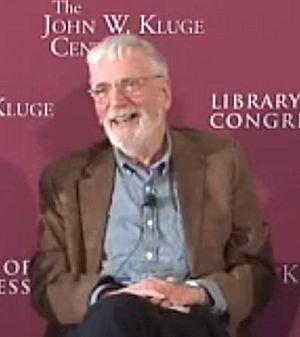Ford Doolittle facts for kids
Quick facts for kids
Ford Doolittle
|
|
|---|---|

Doolittle at the John W. Kluge Center at the Library of Congress in 2016
|
|
| Born |
W. Ford Doolittle
February 21, 1942 Urbana, Illinois, U.S.
|
| Education | Harvard University (BA 1963), Stanford University (PhD 1967), NSCAD University, Nova Scotia (BA in photography) |
| Known for | Horizontal gene transfer in prokaryotic evolution |
| Awards | National Academy of Sciences, Royal Society of Canada |
| Scientific career | |
| Fields | Cyanobacteria, chloroplasts |
| Institutions | Dalhousie University |
| Doctoral advisor | Charles Yanofsky |
W. Ford Doolittle (born November 30, 1941, in Urbana, Illinois) is a famous scientist who studies how living things change over time (this is called evolution). He also studies the tiny parts inside cells (this is called molecular biology). He is a member of important science groups like the US National Academy of Sciences and the Royal Society of Canada. He has won big awards for his science work, including the 2013 Herzberg Medal and the 2017 Killam Prize.
Doolittle has made many important discoveries, especially about very small living things. He helped us understand how chloroplasts (the parts of plant cells that make food from sunlight) first appeared. He also showed how tiny organisms called prokaryotes (like bacteria) can share their genes with each other. This sharing is called horizontal gene transfer and it helps them evolve quickly.
His Education and Career
Ford Doolittle studied at some top universities. He earned his first degree (a Bachelor of Arts) in science from Harvard University in 1963. Later, he got his PhD from Stanford University in 1967. After finishing his studies, he continued his research with other famous scientists.
Since 2007, he has been a professor at Dalhousie University in Halifax, Nova Scotia. Even though he is a "professor emeritus," it means he is retired but still connected to the university and can continue his research.
Big Ideas and Debates
In 1981, Doolittle wrote an article that got a lot of attention. It was called "Is Nature Really Motherly?". In this article, he disagreed with the Gaia Theory. This theory suggests that Earth acts like a single, living system. Doolittle's article is often mentioned by people who don't agree with the Gaia Theory.
Doolittle also has interesting ideas about the "Tree of life". This is a common idea that all living things are connected like branches on a single tree, coming from one ancestor. Doolittle thinks that for some tiny organisms, this "tree" idea isn't quite right because they share genes in different ways (like horizontal gene transfer). Because of his ideas, some people who believe in "Intelligent Design" (the idea that life was designed by a creator) have mentioned his work. However, Doolittle does not support Intelligent Design. He believes in evolution, but he thinks the way we picture it for all life might need to be more complex than a simple tree.
More recently, Doolittle has been part of a discussion about how we understand "function" in biology. This debate started when a big research project called ENCODE said that 80% of our DNA has a "function." Doolittle supports the idea of "junk DNA". This means that not all parts of our DNA necessarily have a clear function, even if they are present.
In 2023, he was chosen as a Fellow of the Royal Society. This is a very high honor for scientists.
Beyond Science
Besides being a brilliant scientist, Ford Doolittle is also an artist! He studied photography at NSCAD University. This shows that scientists can have many different talents and interests.
Awards and Honors
- 2013 Herzberg Medal of the Natural Sciences and Engineering Research Council of Canada
- 2017 Killam Prize

